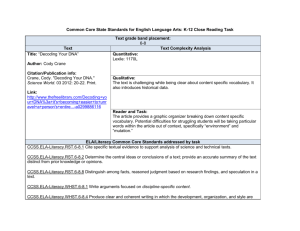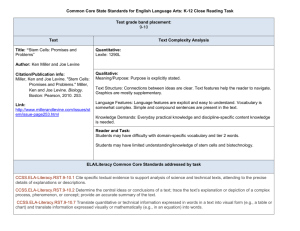Common Core Curriculum 2014-2015 _Unit 3
advertisement
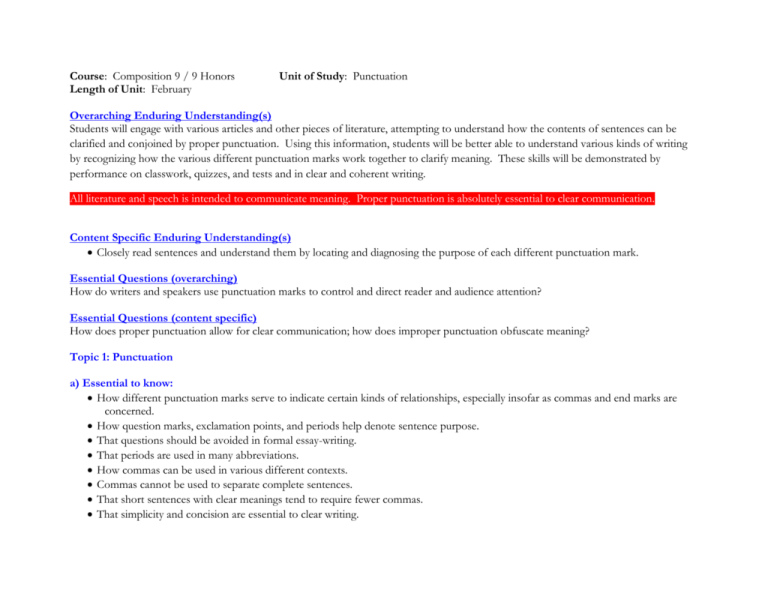
Course: Composition 9 / 9 Honors Length of Unit: February Unit of Study: Punctuation Overarching Enduring Understanding(s) Students will engage with various articles and other pieces of literature, attempting to understand how the contents of sentences can be clarified and conjoined by proper punctuation. Using this information, students will be better able to understand various kinds of writing by recognizing how the various different punctuation marks work together to clarify meaning. These skills will be demonstrated by performance on classwork, quizzes, and tests and in clear and coherent writing. All literature and speech is intended to communicate meaning. Proper punctuation is absolutely essential to clear communication. Content Specific Enduring Understanding(s) Closely read sentences and understand them by locating and diagnosing the purpose of each different punctuation mark. Essential Questions (overarching) How do writers and speakers use punctuation marks to control and direct reader and audience attention? Essential Questions (content specific) How does proper punctuation allow for clear communication; how does improper punctuation obfuscate meaning? Topic 1: Punctuation a) Essential to know: How different punctuation marks serve to indicate certain kinds of relationships, especially insofar as commas and end marks are concerned. How question marks, exclamation points, and periods help denote sentence purpose. That questions should be avoided in formal essay-writing. That periods are used in many abbreviations. How commas can be used in various different contexts. Commas cannot be used to separate complete sentences. That short sentences with clear meanings tend to require fewer commas. That simplicity and concision are essential to clear writing. That grammar and content are not separate, but mutually dependent. MLA Format for take-home assignments. b) Worth being familiar with: That use of the passive voice unnecessarily complicates the typical subject-verb relationship and always leads to unclear writing. That indirect questions do not affect sentence purpose. That not all abbreviations necessitate the use of periods. That some exclamatory sentences look as though they are questions. That imperative sentences can end in periods or exclamation points. That semicolons serve to separate complete sentences and are often used to join together series of sentences. That the oxford comma should be treated as a necessity for the sake of clarity. That commas and end marks should always be placed inside quotation marks when appropriate. That commas often signify that certain contents of a sentence are nonessential. That eliminating words by focusing on the essential parts of a sentence (Subject and Verb) can often lead to clearer writing. c) Teaching Strategies/Learning Activities: Pre-teaching o For each section of unit, have students complete diagnostic exercises from textbook. PowerPoint presentation Guided exercises with teacher o Exercises in textbook, online, and in PDFs Independently completed exercises (classwork) o Exercises in textbook, online, and in PDFs d) Materials: Prentice Hall’s Writing and Grammar: Communication in Action (Gold Level) The Holy Bible (New International Version) Bernard Evslin’s Heroes, Gods, and Monsters of the Greek Myths e) Formative Assessments: Content quizzes (End Marks, Commas) Classwork assignments Short essay o One-paragraph essay tracing the development of the theme of jealousy in one story from Evslin’s Heroes, Gods, and Monsters of the Greek Myths and one story from the Book of Genesis. Students directed to specifically avoid punctuation errors and to try and make sentences concise. f) Summative Assessment: Examination concerning punctuation. o Students provided an article missing 33 punctuation marks which they must insert. g) Standards Addressed: CCSS.ELA-Literacy.RL.9-10.1 Cite strong and thorough textual evidence to support analysis of what the text says explicitly as well as inferences drawn from the text. CCSS.ELA-Literacy.RL.9-10.2 Determine a theme or central idea of a text and analyze in detail its development over the course of the text, including how it emerges and is shaped and refined by specific details; provide an objective summary of the text. CCSS.ELA-Literacy.RL.9-10.3 Analyze how complex characters (e.g., those with multiple or conflicting motivations) develop over the course of a text, interact with other characters, and advance the plot or develop the theme. CCSS.ELA-Literacy.RL.9-10.10 By the end of grade 9, read and comprehend literature, including stories, dramas, and poems, in the grades 9-10 text complexity band proficiently, with scaffolding as needed at the high end of the range. CCSS.ELA-Literacy.W.9-10.1 Write arguments to support claims in an analysis of substantive topics or texts, using valid reasoning and relevant and sufficient evidence. CCSS.ELA-Literacy.W.9-10.1c Use words, phrases, and clauses to link the major sections of the text, create cohesion, and clarify the relationships between claim(s) and reasons, between reasons and evidence, and between claim(s) and counterclaims. CCSS.ELA-Literacy.W.9-10.1d Establish and maintain a formal style and objective tone while attending to the norms and conventions of the discipline in which they are writing. CCSS.ELA-Literacy.W.9-10.1e Provide a concluding statement or section that follows from and supports the argument presented. CCSS.ELA-Literacy.W.9-10.2 Write informative/explanatory texts to examine and convey complex ideas, concepts, and information clearly and accurately through the effective selection, organization, and analysis of content. CCSS.ELA-Literacy.W.9-10.2b Develop the topic with well-chosen, relevant, and sufficient facts, extended definitions, concrete details, quotations, or other information and examples appropriate to the audience’s knowledge of the topic. CCSS.ELA-Literacy.W.9-10.2c Use appropriate and varied transitions to link the major sections of the text, create cohesion, and clarify the relationships among complex ideas and concepts. CCSS.ELA-Literacy.W.9-10.4 Produce clear and coherent writing in which the development, organization, and style are appropriate to task, purpose, and audience. CCSS.ELA-Literacy.W.9-10.5 Develop and strengthen writing as needed by planning, revising, editing, rewriting, or trying a new approach, focusing on addressing what is most significant for a specific purpose and audience. CCSS.ELA-Literacy.L.9-10.1 Demonstrate command of the conventions of standard English grammar and usage when writing or speaking. CCSS.ELA-Literacy.L.9-10.1a Use parallel structure. CCSS.ELA-Literacy.L.9-10.1b Use various types of phrases (noun, verb, adjectival, adverbial, participial, prepositional, absolute) and clauses (independent, dependent; noun, relative, adverbial) to convey specific meanings and add variety and interest to writing or presentations. CCSS.ELA-Literacy.L.9-10.2 Demonstrate command of the conventions of standard English capitalization, punctuation, and spelling when writing. CCSS.ELA-Literacy.L.9-10.2a Use a semicolon (and perhaps a conjunctive adverb) to link two or more closely related independent clauses. CCSS.ELA-Literacy.L.9-10.2b Use a colon to introduce a list or quotation. CCSS.ELA-Literacy.L.9-10.2c Spell correctly. CCSS.ELA-Literacy.L.9-10.3 Apply knowledge of language to understand how language functions in different contexts, to make effective choices for meaning or style, and to comprehend more fully when reading or listening. CCSS.ELA-Literacy.L.9-10.3a Write and edit work so that it conforms to the guidelines in a style manual (e.g., MLA Handbook, Turabian’s Manual for Writers) appropriate for the discipline and writing type. CCSS.ELA-Literacy.L.9-10.4b Identify and correctly use patterns of word changes that indicate different meanings or parts of speech (e.g., analyze, analysis, analytical; advocate, advocacy).
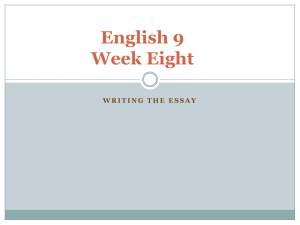



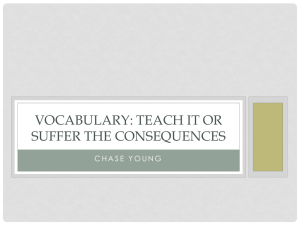
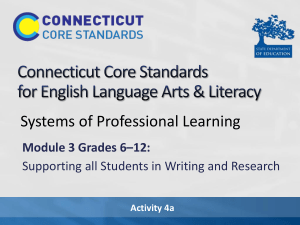
![iPads_and_Writing_2013[1]](http://s2.studylib.net/store/data/005383991_1-1bc8c0f2382c2ccb89e094c534f531f0-300x300.png)
